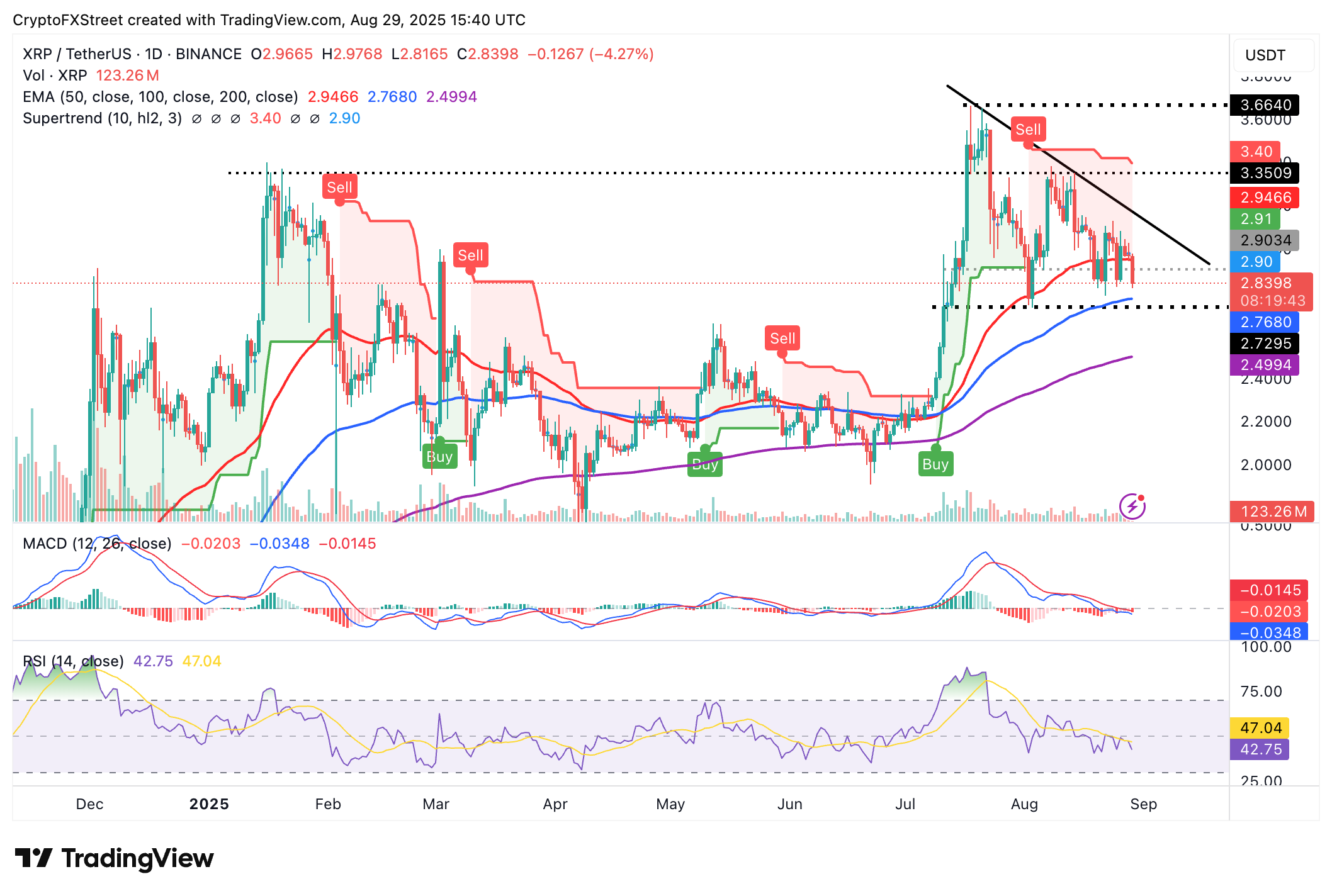Ripple Price Forecast: XRP decline to $2.50 back in play as retail demand dims
- XRP declines for three consecutive days, increasing the probability of plunging to $2.50.
- XRP futures post declining Open Interest as liquidations surge on the backdrop of risk-off sentiment.
- XRP on-chain activity slows with Active Addresses falling by more than half to 24,000 since mid-July.
Ripple (XRP) remains subdued as the bears extend control below the $3.00 pivotal level on Friday. The international money remittance token exchanges hands above the $2.80 round-number support, down over 4% at the time of writing.
XRP's decline can be attributed to several factors, including risk-off sentiment in the broader cryptocurrency market, suppressed interest in risk assets like cryptocurrency ahead of the Federal Reserve's (Fed) September interest rate decision, and a decline in on-chain activity.
If bulls fail to regain control in the upcoming sessions, XRP could kick off September on the back foot. With weak fundamentals taking center stage, technical indicators project an extended drawdown to the support at around $2.50.
XRP faces weak fundamentals amid suppressed on-chain activity
The drop in XRP price reflects a decline in on-chain activity. According to CryptoQuant data, the number of active addresses has plummeted over the last few weeks, from approximately 50,000 in mid-July to around 24,000.
The Active Addresses metric tracks the number of wallets actively interacting with the XRP Ledger (XRPL) by sending or receiving XRP. Hence, such a significant drop indicates a reduction in risk appetite as investors take a step back, leaving XRP susceptible to supply shocks.
-1756483115579-1756483115580.png)
XRP Active Addresses | Source | CryptoQuant
CoinGlass data mirrors the declining interest in XRP, highlighting a noticeable pullback in the futures Open Interest (OI) from $10.94 billion to $7.97 billion over the same period.
As OI declines, interest in XRP wobbles, implying a lack of conviction in the token's ability to recover or sustain an uptrend. This also increases the likelihood of the downtrend continuing in the short term.

XRP Futures Open Interest | Source: CoinGlass
Liquidations have also been on the rise, with over $15 million wiped out in long positions in the last 24 hours. In comparison, short position holders have suffered only $1 million in liquidations, underscoring the risk-off sentiment gripping crypto markets.

XRP Futures Liquidations | Source: CoinGlass
Technical outlook: XRP bearish structure taking shape
XRP price is trading below two key levels: the pivotal $3.00 and the 50-day Exponential Moving Average (EMA), signaling a shift in sentiment from bullish in July to bearish heading into September. Historically, September has been a bearish month in crypto, which could further cause sentiment to deteriorate.
The Moving Average Convergence Divergence (MACD) indicator's sell signal underlines the bearish outlook, with traders likely to continue de-risking to protect their capital.
A sharp decline in the Relative Strength Index (RSI) below the 50 midline indicates a reduction in buying pressure. Should the RSI at 40 extend the decline toward oversold territory, the path of least resistance could remain downward.

XRP/USDT daily chart
Key areas of interest to traders in the short term are the 100-day EMA at $2.76, which is poised to absorb selling pressure and prevent XRP from extending the pullback toward the 200-day EMA at $2.49.
Still, traders cannot ignore the possibility of a knee-jerk rebound, especially after Friday's sell-off across the crypto market. A reversal above $3.00 could restore retail interest in XRP and reinforce the bullish grip, paving the way for a breakout targeting its $3.66 record high.
Ripple FAQs
Ripple is a payments company that specializes in cross-border remittance. The company does this by leveraging blockchain technology. RippleNet is a network used for payments transfer created by Ripple Labs Inc. and is open to financial institutions worldwide. The company also leverages the XRP token.
XRP is the native token of the decentralized blockchain XRPLedger. The token is used by Ripple Labs to facilitate transactions on the XRPLedger, helping financial institutions transfer value in a borderless manner. XRP therefore facilitates trustless and instant payments on the XRPLedger chain, helping financial firms save on the cost of transacting worldwide.
XRPLedger is based on a distributed ledger technology and the blockchain using XRP to power transactions. The ledger is different from other blockchains as it has a built-in inflammatory protocol that helps fight spam and distributed denial-of-service (DDOS) attacks. The XRPL is maintained by a peer-to-peer network known as the global XRP Ledger community.
XRP uses the interledger standard. This is a blockchain protocol that aids payments across different networks. For instance, XRP’s blockchain can connect the ledgers of two or more banks. This effectively removes intermediaries and the need for centralization in the system. XRP acts as the native token of the XRPLedger blockchain engineered by Jed McCaleb, Arthur Britto and David Schwartz.

